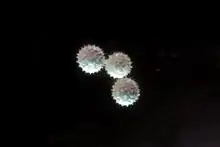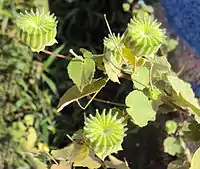Abutilon indicum
Abutilon indicum (Indian abutilon, Indian mallow) is a small shrub in the family Malvaceae, native to tropic and subtropical regions and sometimes cultivated as an ornamental. It is found in Karnataka and Tamil Nadu.[2] This plant is often used as a medicinal plant and is considered invasive on certain tropical islands. Its roots and leaves are used for curing fever.[1]
- Hindi name: कंंघाइ "Kanghai"
- Urdu name: کنگھی "Kanghi"
- Tamil name: துத்தி "thuthi"
- Sanskrit name: अतिबला Atibalaa
- Telugu name: Duvvena Kayalu "duvvena benda"(దువ్వెన బెండ)
- Kannada name: TuThThi gida (ತುಥ್ಥಿ ಗಿಡ)
- Malayalam name:വെള്ളൂരം
- Odia name: ପେଡ଼ି ପେଡ଼ିକା "Pedi Pedika" [3]
| Abutilon indicum | |
|---|---|
 | |
| Scientific classification | |
| Kingdom: | Plantae |
| Clade: | Tracheophytes |
| Clade: | Angiosperms |
| Clade: | Eudicots |
| Clade: | Rosids |
| Order: | Malvales |
| Family: | Malvaceae |
| Genus: | Abutilon |
| Species: | A. indicum |
| Binomial name | |
| Abutilon indicum | |
| Synonyms | |
|
Sida indica L. | |


Distribution
The species occurs in a number of tropical and subtropical zones. An example occurrence is within parts of the Great Barrier Reef islands of the Coral Sea.[4]
Traditional medicine
In traditional medicine, A. indicum various parts of the plant are used as a demulcent, aphrodisiac, laxative, diuretic, sedative, astringent, expectorant, tonic, anti-convulsant,[5] anti-inflammatory,[6] anthelmintic, and analgesic and to treat leprosy, ulcers, headaches, gonorrhea, and bladder infection.[7] The whole plant is uprooted, dried and is powdered. In ancient days, maidens were made to consume a spoonful of this powder with a spoonful of honey, once in a day, for 6 months until the day of marriage, for safe and quick pregnancy.[8]
The plant is very much used in Siddha medicines. The root, bark, flowers, leaves and seeds are all used for medicinal purposes by Tamils. The leaves are used as adjunct to medicines used for pile complaints. The flowers are used to increase semen in men.[9]

Chemistry
β-Sitosterol is present in A. indicum and a petroleum ether extract has larvicidal properties against the mosquito larvae Culex quinquefasciatus.[10] A methanol extract of A. indicum has some antimicrobial properties.[11]
References
- "Abutilon indicum". Pacific Island Ecosystems at Risk. Retrieved 2008-06-18.
- Matlwaska (2002). "Flavonoid compounds in the flowers of Abutilon indicum (Linn.) Sweet" (PDF). Acia Poloniac Pharmaceutic - Drug Research. 59 (3): 227–229.
- "Archived copy". Archived from the original on 2016-12-18. Retrieved 2016-12-06.CS1 maint: archived copy as title (link)
- C.Michael Hogan (2011). "Coral Sea". In P. Saundry; C.J. Cleveland (eds.). Encyclopedia of Earth. Washington DC: National Council for Science and the Environment.
- Anticonvulsant activity of Abutilon indicum Leaf. Dharmesh K Golwala, Laxman D Patel, Santosh K Vaidya, Sunil B Bothara, Munesh Mani, Piyush Patel. International Journal of Pharmacy and Pharmaceutical Sciences (IJPPS) (ISSN 0975-1491), Sagar, India. 2010: Volume 2, Issue 1, page: 66-72.
- Anti-inflammatory activity of Abutilon indicum Linn. Leaf. DK Golwala, LD Patel,SB Bothara, SK Vaidya, AR Sahu, S Kumar. Research Journal of Pharmaceutical & Technology (ISSN Online: 0974-360X; Print: 0974-3618), Raipur, India. 2010: Volume 3, Issue 1, page: 433-439.
- Nishanta Rajakaruna; Cory S. Harris; G.H.N. Towers (2002). "Antimicrobial Activity of Plants Collected from Serpentine Outcrops in Sri Lanka" (PDF). Pharmaceutical Biology. 40 (3): 235–244. doi:10.1076/phbi.40.3.235.5825. S2CID 53004266.
- Pandikumar, P.; Chellappandian, M.; Mutheeswaran, S.; Ignacimuthu, S. (2011). "Consensus of local knowledge on medicinal plants among traditional healers in Mayiladumparai block of Theni District, Tamil Nadu, India". Journal of Ethnopharmacology. 134 (2): 354–362. doi:10.1016/j.jep.2010.12.027. PMID 21193023.
- J.Raamachandran, "Herbs of Siddha Medicines – The First 3D Book on Herbs, p. 4
- A. Abdul Rahuman; Geetha Gopalakrishnan; P. Venkatesan; Kannappan Geetha (2008). "Isolation and identification of mosquito larvicidal compound from Abutilon indicum (Linn.) Sweet". Parasitology Research. 102 (5): 981–988. doi:10.1007/s00436-007-0864-5. PMID 18176816. S2CID 845151.
- Jigna Parekh; Nehal Karathia; Sumitra Chanda (2006). "Screening of some traditionally used medicinal plants for potential antibacterial activity". Indian Journal of Pharmaceutical Sciences. 68 (6): 832. doi:10.4103/0250-474X.31031.
External links
| Wikimedia Commons has media related to Abutilon indicum. |
- Abutilon indicum, Indian Mallow Sinhalese Name:Beheth Anoda Indian Mallow, Abutilon
- Abutilon indicum photo
- Abutilon indicum (Linn.) Sweet Medicinal Plant Images Database (School of Chinese Medicine, Hong Kong Baptist University) (in Chinese) (in English)